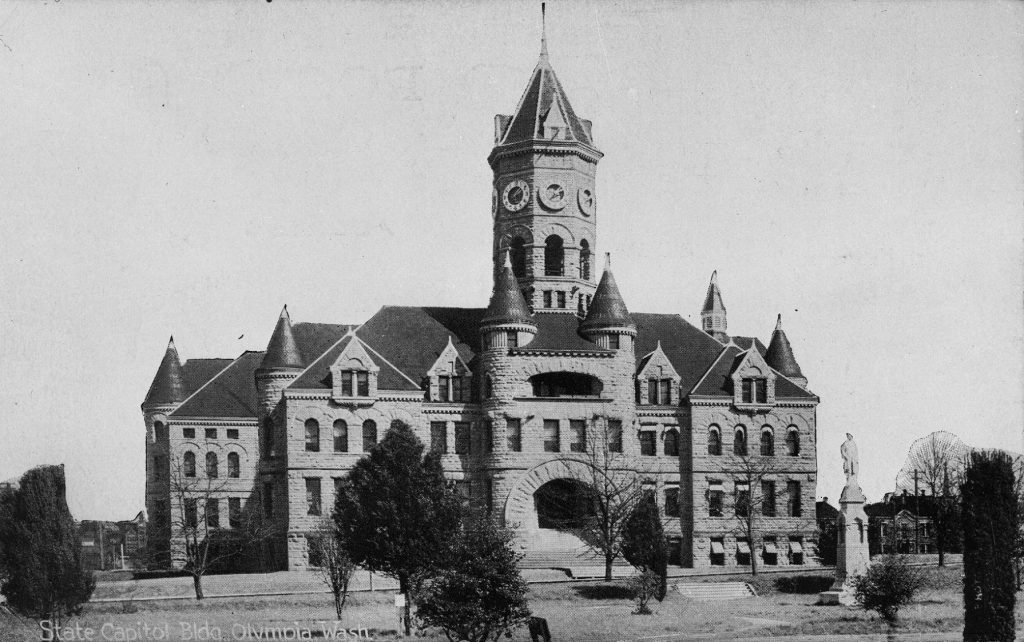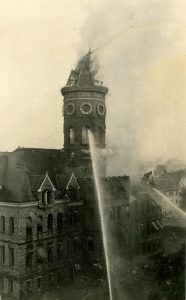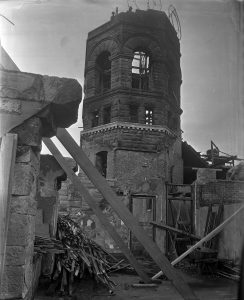At 3:35 p.m. on Saturday, September 8, 1928 janitor William Todd spotted dense smoke billowing from the base of the tower and eaves of the roof of the Old State Capitol in Olympia. He immediately turned in an alarm to the fire department. It was not a moment too soon. Within minutes the entire roof was on fire and the building’s landmark tower was a pillar of flame.
 The Old State Capitol was originally built in 1891 as the Thurston County Courthouse. Designed by architect Willis Ritchie (1865-1931), the building was ironically meant to be fireproof. No wooden framing was used under the ornamental tin roof and floor joints were made of steel. Public areas were floored with glazed tile.
The Old State Capitol was originally built in 1891 as the Thurston County Courthouse. Designed by architect Willis Ritchie (1865-1931), the building was ironically meant to be fireproof. No wooden framing was used under the ornamental tin roof and floor joints were made of steel. Public areas were floored with glazed tile.
The crowning glory of the building, however, was a 150-foot-tall octagonal clock tower. A local landmark, each of its eight clocks were illuminated with electric lights. The building soon proved too costly for Thurston County to pay for.
Meanwhile the state government was facing its own problems. They had outgrown their wooden territorial building but the Panic of 1893 halted construction of a new capitol. In 1901, the legislature appropriated $350,000 to purchase the courthouse. Ritchie was rehired to design a new wing for the building that more than doubled its size. By 1905 the legislature, supreme court, executive departments and state library were moved to the building.

While some hoped the capitol could be used for 50 years, the government quickly outgrew the building. In 1911 the legislature authorized the construction of the modern capitol campus, and by 1928 most offices had relocated. Space was limited on the new campus, however, and several departments remained in the old building at the time of the fire.
The blaze began on the third floor of the older west wing, climbing into the attic and tower. All available Olympia firefighters and equipment were called to the scene, but had difficulty reaching the fire in the attic. Water uselessly splashed off the metal roof. Firefighters pulled several lines into the inferno itself, fighting the fire directly. Two firefighters narrowly missed being flattened by a heavy brass chandelier that fell three stories in an area between the legislative chambers while several others were overcome by smoke inhalation.

After 20 minutes, fire department officials realized they did not have the men—even with many volunteer firefighters joining the professionals—or equipment to fight the fire and called the Tacoma Fire Department for help. Tacoma Engine Company No. 8 raced the 32 miles between their station and the capitol through heavy weekend traffic in 35 minutes. With their taller ladders, Tacoma firefighters carried their hoses onto the slippery roof and made holes in the roof to fight the fire from above. “One fireman,” The Olympian wrote the next day, “carried a lead of hose directly into the tower, which was burning furiously, and sat nonchalantly in a window of the tower directing his stream at the heart of the blaze while his comrades below protected him with another stream of water.”
The firefighters were hampered by the estimated 6,500 people who thronged nearby streets to watch the inferno. At one point it seemed like the clocktower might collapse over Washington street and firefighters ran ropes between trees in attempt to keep people back.
Hundreds of volunteers, including local Boy Scouts—some of whom joined the hose line—rushed to remove records and furnishings from the building. This included a heavy oak-framed portrait of George Washington.
The fire was under control by 5 p.m. and extinguished by 5:30 p.m. Its faithful clocks had continued to run during the fire, until hit by the fire hose. The last clock stopped running at 4:47 p.m.
Six watchmen were placed around the building that night. Early the next morning a team of workers began cleaning out debris—and keeping away visitors who came from around the region hoping to get an up-close glimpse at the destruction.

The greatest damage occurred in the southwest corner of the building. The Department of Public Works was exposed to the elements, but water also seeped into the offices below and down the stairs into the basement. Public Works papers, largely stored in wooden crates, were moved temporarily to former committee rooms behind the old legislative chambers.
An official cause for the fire was never determined. Some blamed the heating system while others pointed to defective exposed wiring. A few even suspected arson.
While rebuilding and repairing work began within 10 days after the fire and was completed in 3 months, the tower was not rebuilt. A low tower with a single-faced clock was proposed. People were outraged. One letter written to the Daily Olympian newspaper declared that the cost of restoration was small and that the tower should be rebuilt as it was. “Besides,” the writer added, “the clock is like an old friend.” In the end Olympia’s friend was replaced by a large dormer window between the front two turrets.
The building’s troubles were far from over. The old capitol suffered extensive damage during the 1949 earthquake that destroyed all but two of its turrets. It was placed on the national register of historic places in 1975. Then in 1981-1983 the structure underwent a $9 million renovation. Two new towers were placed at the east side. An art glass window of the state seal was created for the dormer window that had replaced the clock tower.
The historic old capitol is a survivor of economic depressions, three major earthquakes and a devastating fire. Now as the headquarters of the Office of the Superintendent of Public Instruction, it continues to be a local landmark.
















































